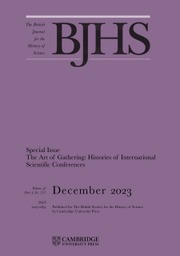Sir Joseph Banks (1743–1820) was one of the great letter writers of the late Georgian period, and the publication of his correspondence, begun in earnest during the 1970s and continuing today, represents a Herculean task with rich results. Neil Chambers, who helms the editorial efforts of this venture, continues the work initiated by his predecessor Harold Carter in the most recent edition of Banks’s published letters, which brings together 792 separate documents from over two hundred writers, linked by their connections with the subject of Africa in the period from 1767 to 1820.
The gathering impetus of Banks’s editors invites comparisons to the man himself, whose vast network of botanical collectors, correspondents and explorers has dominated recent scholarly accounts of this longest-serving president of the Royal Society. Of the estimated 100,000 letters written during his lifetime, around 20,000 remain. Since the nineteenth century, these have been scattered to over 150 repositories worldwide. The publication of Banks’s correspondence offers a corrective to this state of affairs, and many library shelves groan under the weight of the resulting volumes. Beginning with Carter’s Sheep and Wool Correspondence (1979) and continuing in Chambers’s Letters of Sir Joseph Banks (2000), Scientific Correspondence (2007) and Indian and Pacific Correspondence (2007–14), as well as Anna Agnarsdóttir’s volume on Iceland and the North Atlantic (2016), a huge amount of energy has been spent on making these resources available. The African Correspondence stands in this tradition. Published in three volumes, it consists of a contextualizing introduction, a statement on editorial principles, lists of key dates, the edited letters themselves and a substantial calendar of correspondence.
Since 1990, the publication of Banks’s letters has taken place under the aegis of the Sir Joseph Banks Archive Project, of which Chambers is executive director. His involvement with the project, begun in 1996, has lent the undertaking a sense of continuity apprehended most clearly through a consistent editorial approach. The African Correspondence, as with earlier volumes, is arranged according to the organizing methods and standards that Carter established in 1979. This has helped mitigate the difficulties of publishing such multi-volume historical reference works, which can take many years to prepare, finance and execute, often necessitating the use of different publishers or editors and divergent approaches to the presentation of content. In translating manuscript material to the printed page, Chambers also marshals his familiarity with Banks’s notoriously difficult hand and idiosyncratic writing style, rendering borderline unintelligible material useful.
The achievements of the volumes are therefore primarily editorial. These are scholarly and informed works of reference for the specialist (and are priced as such), and they stand as a testament to the editor’s deep knowledge of Banks and writing practices in the period. The calendar of correspondence (vol. 3, pp. 390–517), is an especially useful update to parts of Warren Dawson’s indispensable Banks Letters (1958), in which a number of repositories, private collections and references are now out of date. Chambers’s volumes also include a greater amount of annotation and commentary than past editions, building on the contributions of previous works even as they revise them.
As an instance of historical analysis, less is especially notable. The volumes will therefore be most successful in heightening awareness of Banks’s interest in African exploration amongst historians of science, empire and travel and in making a wealth of relevant source material readily available. Gathering disparate letters to and from such explorers as James Bruce, Friedrich Conrad Hornemann, Mungo Park and John Barrow, as well as Francis Masson, the first plant collector dispatched from the Royal Botanical Gardens at Kew, shows the extent to which Banks engaged with individuals responsible for introducing European audiences to the geography, cultures and produce of Africa. As a result of his own travels with James Cook, Banks was often compared to Bruce, whose search for the origins of the Nile captured the imagination of the late Georgian public in a manner comparable to earlier tales of the South Seas. Though ‘eclipsed’ by his reputation as a supporter of Indo-Pacific exploration, as Chambers reminds us, Banks’s promotion of similar efforts in Africa was extensive (vol. 1, p. 73). His prominent role in determining the activities of the African Association is therefore afforded considerable space in the long introduction, as is his ambiguous attitude toward slavery and the abolitionist cause, a timely contribution to discussions of these subjects which teases but ultimately fails to deliver compelling insights.
There are some drawbacks, most unavoidable given the nature of the endeavour. The sole focus on letters, for example, is cause for omission of important non-epistolary documents, visual material or objects. Chambers has helpfully included instances of the first of these, but restrains such treatments in order to remain within the scope of the correspondence project. Visual material and objects also introduce difficulties where publishing is concerned, but these are vital sources for understanding Banks and his activities. Chambers’s 2014 exhibition and catalogue Endeavouring Banks (2016) demonstrate an awareness of their value, and, as well as his research on collecting and the British Museum, should be read alongside the letters. Finally, at least one error makes its way into the text, that being the confusion of Boston, Lincolnshire, with Boston, Massachusetts, when citing one of Bruce’s letters held by the Public Library located in the latter (vol. 1, pp. 79, 105–6).
As a contribution to the corpus of published Banks letters, these volumes must be seen as the latest instalment in an ambitious and admirable enterprise. As with earlier editions, they offer a cornucopia of useful information and add much stock to the material from which historians of the period might draw. In addition to reorienting our appreciation of Banks’s role in African affairs, the volumes are a credit to the editor’s efforts and long association with a project that has benefited from the support of many institutions and individuals. Banks himself would surely applaud such a feat.



